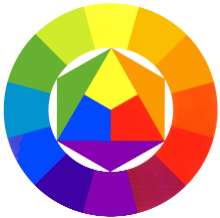|
 |
RSS Feed  |
a playground of art, photos, videos, writing, music, life |
|
|

You are here
|

Creativity!
|

Get it!
|

I like it!
|

Fun stuff!
|

About me...
|
| |
|
|
|
|
Random Quote
I can't offer you light at the end of the tunnel because I can't see it myself, but you're not alone in the tunnel.
-- Unknown
|
|
|
|
|
|
|
|
|
|
Blog - Blog Archive by Month - Blog Archive by Tag - Search Blog and Comments
|
<-- Go to Previous Page
Hue, Value, and Intensity |
 Betty Edwards writes in her book, Color: "Everything about color has to do with relationships, and the questions you need to ask in order to understand color are all about relationships." Betty Edwards writes in her book, Color: "Everything about color has to do with relationships, and the questions you need to ask in order to understand color are all about relationships."
What you see at right is a color wheel. If you start with the three primary colors, and then add the secondary colors (giving you six colors), and then add the color that is a mixture of the adjacent primary and secondary colors, you then have twelve colors. What combinations of colors please the eye? Studies have found that opposites do. For example, purple and yellow, or red and green. To show that this is true, several people have complimented my current painting, a still life of a red pepper and a sliced red onion. The red pepper is a bright red with a green stem. The onion is purplish with yellow highlights. This was quite by accident on my part - I was simply painting what I saw. But as I step back from it, I do see that aspect. Artists also find that triads - creating a color and then using the fourth from it and then the fourth again - creates a harmonious mix. Red, yellow, and blue are one example. Orange, purple, and green would be another. I doubt that it has anything to do with this, but music also has twelve notes between octaves. To create a harmony, you use not the opposite or triads, but rather fifths or sevenths. But there's a rhyme and a reason to understand harmony in both color and music. So... I wonder how this idea of hue (a color from the color wheel), value (light or dark), and intensity (bright or dull) transfers to harmony in friendships and marriages. I'm too tired now to consider it more, but I'll be thinking of it... ETC: More in the comments... |
|
|
|
| Comments
|
Western music, based on Pythagorean Pitch Ratios (n:n+1) have twelve (spaced) tones per octave. Other cultures employ unevenly spaced tones and have 14-22 tones per octave. Likewise, the color wheel you present is only one form of color space (RGB). You can develop similar mathematical theory using CMYK, CIE, Munsell, or Ostwald color spaces. What is color? What is sound? Are they real? We come up with all kinds of mathematical structure to help understand how our brains interpret the physical responces of our eye cones and our cortial hair, based on the physics of photons, EM waves, and compression waves. Does all this help us understand light and sound, or help us understand our mind? Is a purple onion and a red pepper pleasing to the eye because of the colors or because of hardwiring in our brain? Maybe those color combinations are good because onions and peppers are nutritious food. |
| | Posted by Anonymous, 3/23/2005 1:36:38 AM |
|
|
Wow - killer comment from someone smarter than me about this stuff. The purple/yellow and red/green combinations are opposites on the color wheel. As Edwards' points out in her book, you can choose three or four colors at random and then choose each color's opposite on the color wheel and create a design using these, and people generally find the work pleasing. Likewise, you hear people say that in relationships, opposites attract. Harmony. I'm not saying that they're related, but it's interesting. Take a group of jazz players. One guy begins with a simple and melodic riff, and the others will then harmonize with that and play against it. The more abstract and loose, the tougher it is for people, in general, to appreciate what the group is doing. We look at couples, and sometimes it's obvious how they work and click together in their relationship. People see a pleasing harmony in the mix of the two of them. Other times, no one gets it. They're like a difficult jazz duo who make most in the audience feel awkward in the interpretation. Or they're a Jackson Pollack painting. In a relationship, you need certain aspects to be similar and not opposite. A relationship where one person wants children and the other doesn't, or where one person is deeply religious and the other is not - these will cause a lot of friction and bring little harmony. But where one person is quiet and the other outgoing, this seems to work. Where one person is good with money and the other person is happy not to have to deal with the checkbook, this is harmonious. Gotta get ready for work... :) |
|
|
Add Your Comment:
|
|
|
|
|
|